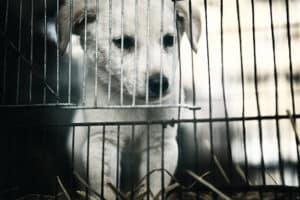This particular phobia and frequently encountered condition in mostly dogs is a fear of restriction which varies from one individual to another and may be manifested indoors or outdoors.

The development of this fear may be due to a genetic predisposition, classical conditioning or a decreased size of the amygdala in the brain of the symptomatic individual. There are some differences in this condition between animals and humans where, to a large extent, 2% to 5% of the latter population suffers from this. Some people may exhibit cabin fever after a traumatic experience and some can be psychologically and neurotically influenced. Those that are symptomatic usually feels the danger, or suffocation aspects, of the confinement. In animals it is basically the intolerance of confinement due to the lack of exposure during the early impressionable period of life.
If kittens and puppies are crate-trained or restricted with pleasantries and rewards they will easily tolerate and adapt to small spaces once they are adults. It has to be learnt. Dogs suffering from autophobia, or car sickness, may well be vomiting or salivating from motion sickness, as well as the confinement of a car.
The amygdala is one of the most powerful structures in the brain. This organ is responsible for the conditioning of fear and the display response of the fight or flight syndrome. The anterior nuclei associated with fear interact with each other and transfer impulses to other nuclei, which then have a direct effect on the expression of a variety of physiological survival functions such as respiratory rate, adrenaline release, heart rate, behavioural response to fear or defensive response of fight or flight. These reactions constitute failure of the autonomic system in a panic attack. Some research in humans has proved that the right amygdala is smaller in patients with panic disorder.
In classical conditioning the mind connects restriction with all types of potential dangers. This may be as a result of a previous traumatic experience during the imprinting age period or, on the other hand, having had no exposure or association with confinement during the impressionable period of youth, which is up to twelve weeks in a cat and five months in a dog. In animals claustrophobia is not really acquired or indoctrinated through neurosis or social influence, but rather has some genetic basis and lack of early positive experience with confined spaces such as crates, cars and rooms.
The genetic basis is based on breed and individual. Dog breeds which are classified as working, guarding, sporting and hounds will be far less tolerant of confined areas so teaching any puppy in these categories will have to start much earlier; usually from six weeks of age onwards, which is post-weaning.
Some breeds most likely to be claustrophobic are Dobermann Pinscher, Border Collie, Siberian Husky, Belgian Shepherd, German Shepherd, Jack Russell Terrier, Bernese Mountain Dog, Airedale Terrier, Basset Hound, Beagle, Dalmatian, Rhodesian Ridgeback, Weimara-ner, Irish Setter, English Springer Spaniel, Golden Retriever, Labrador and Boxer.
One of the reasons why veterinarians and animal behaviourists promote puppy socialisation and basic obedience training is to teach the young animals co-ping skills for later on in life. One of the coping skills a pup has to be taught is the acceptance and tolerance of confinement in case veterinary hospitalisation, boarding or transporting is required. One has to merely observe dogs in these restricted facilities to judge which animal has a responsible owner.
The dog that sleeps on its blanket, relaxed and calm, is the epi-tome of positive socialisation and training. The dog that is consistently howling, yapping, barking or displaying any other form of known canine vocalisation being expressed rhythmically, obsessively, and in exacerbated form is showing a form of claustrophobia.
The dog that paces, chews food dishes and water bowls, tipping all its contents on the floor, with a reduced appetite, and hyperventilating, is highly anxious and stressed with confinement. This should never be if taught young!
Then there is the serious claustrophobic case bordering on dementia with no learned response to cope.
To escape from entrapment the dog will chew on bars, welded mesh and expanded metal completely destroying the cage, sometimes breaking teeth and injuring gums in the process.
Some will dig under a gate perpetually until the feet and paws bleed, the floor is dug through and the dog is in a stupor, focused on wanting to get out. One can never truly predict this reaction until it happens.
The damage is usually expensive, the dog’s injuries usually heal rapidly, but the occurrence of serious claustrophobia has serious ramifications for the owner and welfare of the manic animal.
Want to ask Dr. Platzhund a question? Send us an e-mail [email protected] or leave a comment below.






